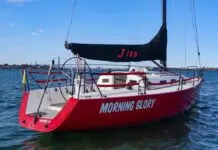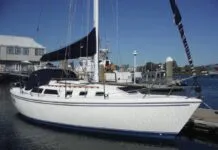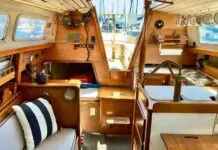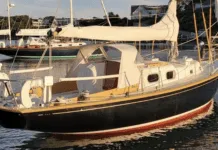Beneteau First 345 Used Boat Review
The Beneteau First 345 was designed as a moderate displacement racer/cruiser, and much of its popularity has been because of its success in blending the two functions. In fact, it could be said that the First is a racing boat that contains a cruising interior. The architect is Jean Berret, a Frenchman noted for his cruising and racing designs (he designed the 1985 Admiral's Cup winner, Phoenix, a Beneteau one-tonner).
Irwin Citation 34 Used Boat Review
The Irwin 34 is in many respects a typical Irwin boat. It was originally called the "Citation 34," which was meant to indicate that it was more of a plush cruiser than the race-oriented Irwins at the time, but more of a racer than the larger cruisers. According to the company, 305 Irwin 34s were built in the production run, from 1978 to 1985, a moderate but successful model for the era. Near the end of its production, the boat was advertised as the Irwin 34 rather than the Citation 34. There were no major changes in the boat from beginning to end, just the details and equipment that are typical of any long production run.
Hunter 33 (Hunter E33) Used Boat Review
Practical Sailor recently test sailed Hunter Marine’s new Hunter 33, a redesign of the company’s popular compact cruiser. The most noticeable difference between the new Hunter 33 and its predecessor is the new deck plan, which includes a hinged transom cutout that folds down into a swim platform, offering more cockpit space and an expanded main cabin. The hull and steering setup also have seen some revamping, and testers found the boat to be fun to sail, even with in-mast furling and a batten-less main in the test boat. For a new, entry-level cruiser priced at $160,000, the Hunter 33 has a lot going for it.
J/109 Used Boat Review
The J/109 is a 35-ft. boat that races well and has some comforts for short term cruising. It is a true racer/cruiser. The first...
Catalina 34 Used Boat Review
American sailboat manufacturers have had their highs and lows, and many have dropped right off the map, but Catalina has been going strong for more than four decades, and looks to be gearing up for at least 40 more. If you want a history lesson in how owner Frank Butler navigated this company through a fickle, cyclical industry, you can check out one of our many reviews of Catalina boats online at www.practial-sailor.com. The more recent trends are the most relevant to this boat review, an update to one originally published in 1991.
Ranger 33 Used Boat Review
The Ranger Yacht division of Jensen Marine was created in 1969 to build performance-oriented boats designed by Gary Mull. Jensen's Cal division had been successful with both racer/cruisers and pure cruisers, but the Ranger line was racier, with consistent styling and appearance throughout the series. Ranger stopped building the 33 in 1978, after 464 boats had been turned out. Many minor changes were made over the years of production, and boats built after 1974 are generally more desirable, with restyled interiors and a diesel engine option.
Pearson Alberg 35 Used Boat Review
While the Alberg 35 had moderate success as a racer, the boat was--and still is--a cruising boat. By current standards, the Alberg 35 is a slow boat for her length overall, with a typical PHRF rating of 198. By way of comparison, her replacement, the Pearson 35, rates about 174, and the Ericson 35-2 about 150.
Alberg 35 Offers Classic Escape
The Alberg 35 dates back to the dawn of big-time fiberglass sailboat building. Its production began in 1961, just a year after Hinckley stopped building production wooden sailboats. Two years earlier, in 1959, Pearson built the first Triton, the boat that was the prototype of the inexpensive, small family, fiberglass cruising sailboat. The Tritons big selling point was a low-maintenance hull that Mom and Pop and the kids didnt have to spend all spring in the boatyard, getting it ready for the summer.
Hans Christian 34/36
Hans Christian 34/36 - While not a good boat for the weekend coastal cruiser, or for anyone who does much sailing in light-to-moderate air, this is an excellent choice for the serious blue-water sailor. This is a boat that will take you offshore to Bermuda or just about anywhere and will stand up to a gale. The 34/36 wont get you there fast, but it will get you there safely.
Catalina 320 Used Boat Review
The Catalina 320 is pleasing to the eye, partially a reflection of a finer bow entry. While it has a modest overhang at the bow and almost none at the stern, with a waterline of 28' it's clearly the product of the nearly plumb bow/reverse stern thinking so prevalent in architectural circles these days.


















































